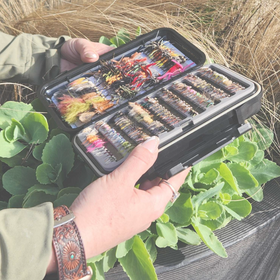Well, let's go one step further shall we? Saltwater fly fishing is the epitome of everything said in the previous paragraph and more. Even for the seasoned fly fishing trout angler, saltwater fly fishing looks like an impossible task, to say the least. For one thing the ocean is huge, enormous, and might as well be unending. Even the most competent caster can only cover a ridiculously minute portion of the area why would one even bother. When scanning a river or lake, one can have an educated guess about where the fish will lie. But the ocean? Where they can be anywhere can't they, and then you have the whole business of the tide to learn. It isn't seasonal, it is daily. And then we have the myriad of flies to learn about all over again. It took years to learn about trout flies, and it is still ongoing, one must really start all over again?? Ugh!
Yes it is daunting, but remember when you first learned about fly fishing in general. Or frankly any new hobby or topic. It is all daunting at first. Learning is daunting, but becomes easier, as the new area of interest is unveiled slowly. A little knowledge to start, to hang later more detailed knowledge on is the most crucial. So let's start with just a little knowledge.
If you are in an area where saltwater fly fishing is well practiced, you are in an easier position to obtain such knowledge, by asking fly shop owners, and fly fisher's, and by observation you can begin to get a feel for what it is all about. But much of the world's saltwater fly fishing opportunities are virtually unexplored.
So let's see what we can do to break this down. Like fishing lakes and big rivers, you have only look at the territory you can actually cover with your fly rod. And pretty much ignore the rest. For saltwater fly fishing that territory is the 60 feet or so next to shore. The easiest way to explore this area is by foot at low tide, when you can actually see the underwater terrain. You can first invest in a chart or survey map, to help you narrow down areas that might have rocky outcroppings leading into deeper pools or channels. If you have loads of free time, this can become an enjoyable activity of exploration all in itself. Look for activity of fish, and habitats that might hold fish and their food. One nice thing here is that fish are fish are fish, and they all require the same thing. Security, food, places to lie, if you know how to read habitat in rivers or lakes you can easily adapt that skill to oceans, and bays.
Once you have your spots located, you will also need some gear. If you have some 8 wt gear or larger, you can least begin to get your feet wet. As for flies, well start with the basics, the classics, Deceivers and Clousers, will give you the best opportunity to catch a fish. And you have begun to add that crucial beginning of knowledge onto which you will hang new knowledge as you become more versed in this field of fly fishing.




